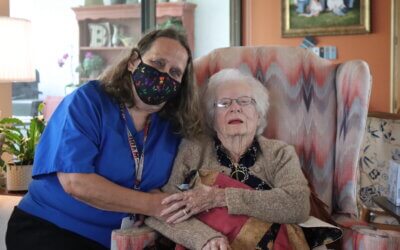5 Most Important Ways Telehealth Helps Home Care Patients
A clinical administrator with Chapters Health Home Care helps identify the 5 most important ways telehealth helps home care patients.
 Senior woman having online consultation with her doctor in a video call
Senior woman having online consultation with her doctor in a video call
Advances in technology made many aspects of our everyday lives easier. Bluetooth, video conferencing, tablets, you name it. Some people believe those pieces of technology negatively affect us in some ways, such as undermining the importance of face-to-face interaction. In home care, it’s the opposite. These ever-evolving devices are becoming an increasingly valuable tool for home health care providers, such as Chapters Health Home Care, and their patients.
The Importance of Telehealth
A 2020 study included in the journal of Commuters Informatics Nursing shows telehealth helped patients with congestive heart failure manage their symptoms. That same study showed the adoption rate for telehealth was still relatively low, due to factors other than care satisfaction, but it increased as a result of the COVID-19 pandemic. Mark Stevenson, a clinical administrator for Chapters Health Home Care, explains the five most important ways telehealth has helped home care patients.
1. Empower Home Care Patients and Caregivers
The telehealth program at Chapters Health Home Care allows for more observation of the patient’s vital signs through devices such as pulse oximeters, blood pressure cuffs, glucose monitors and scales. All the devices are connected to a tablet via Bluetooth, allowing for a seamless transfer of data to the patient’s home care team. Stevenson believes this allows for a better understanding of how the patient is feeling.
“So, instead of a home health nurse coming out once a week to gather data and perform exams, the telemedicine devices can prompt daily checking of various vitals and ask sets of questions. I think it gives the patient and caregiver more of a stake in monitoring and being responsible for their own health, which is vital in long term management of chronic illnesses.”
2. Catch Home Care Complications Sooner
As Stevenson previously said, the telehealth infrastructure at Chapters Health Home Care allows for daily checks of vitals and questionnaires on the patient’s condition. This allows a patient to quickly consult with his or her care team in real time and receive timely treatment.
“The biggest positive experience from telehealth is the ability to monitor a patient daily without having to come into a physical office,” said Stevenson. “While it cannot completely eliminate in-person visits, it can help increase the reach of healthcare providers and improve care for their patients.”
One concern for a home care patient is accuracy. How can a patient be sure the data and images they’re providing through telemedicine ensure a proper treatment plan?
“The nurses educate the patients on proper use of the equipment,” said Stevenson. “The system also assists with recognizing when there is improper usage, such as misplacing the pulse oximeter on your finger. The system will notify the patient when they need to readjust the equipment.”
3. Infection Control
It’s an obvious inclusion, but it’s importance can’t be understated in the midst of the COVID-19 pandemic.
“We have used the telehealth machines during the COVID-19 pandemic to assist us in increasing the ability for our staff to safely monitor patients while decreasing the chance for acquiring the virus,” said Stevenson. “It is such a valuable tool to not only assist with patient care, but also for many other facets of healthcare, even administrative tasks.”
According to several studies, gathered by the National Center for Biotechnology Information, telehealth is very effective in not only preventing transmission of COVID-19, but also providing safe continuous care to patients.
4. Telehealth is Versatile
Many home care patients may wonder if their illness is appropriate for telehealth. In fact, many chronic illnesses can benefit from the program.

“Some of the most common ones this technology is used for are hypertension, diabetes, end-stage renal disease, congestive heart failure (CHF) and chronic obstructive pulmonary disease (COPD). But this can be used for almost any type of disease monitoring in one fashion or another.”
5. Reduce Hospital Readmissions
According to the Partnership to Fight Chronic Disease, people with chronic diseases account for 81 percent of hospital admissions. What if we could reduce that? How much money could we save patients and providers by reducing readmissions?
“I think telehealth is an extremely valuable tool to assist with patient care throughout the healthcare continuum,” said Stevenson. “It allows for comfort and convenience by allowing for visits to still take place at home.”
That’s the principal goal of home care and telehealth can help achieve it. The daily updates digital tools provide reduce the chances of a lapse in treatment. Patients feel better, longer. That means they stay where they want to be, at home.
Chapters Health System is committed to serving the needs of its patients, families, caregivers, health providers, partners and communities.
For more information, please call our helpful Chapters Health team at 1.866.204.8611 or Contact Us.
Keep Exploring

















